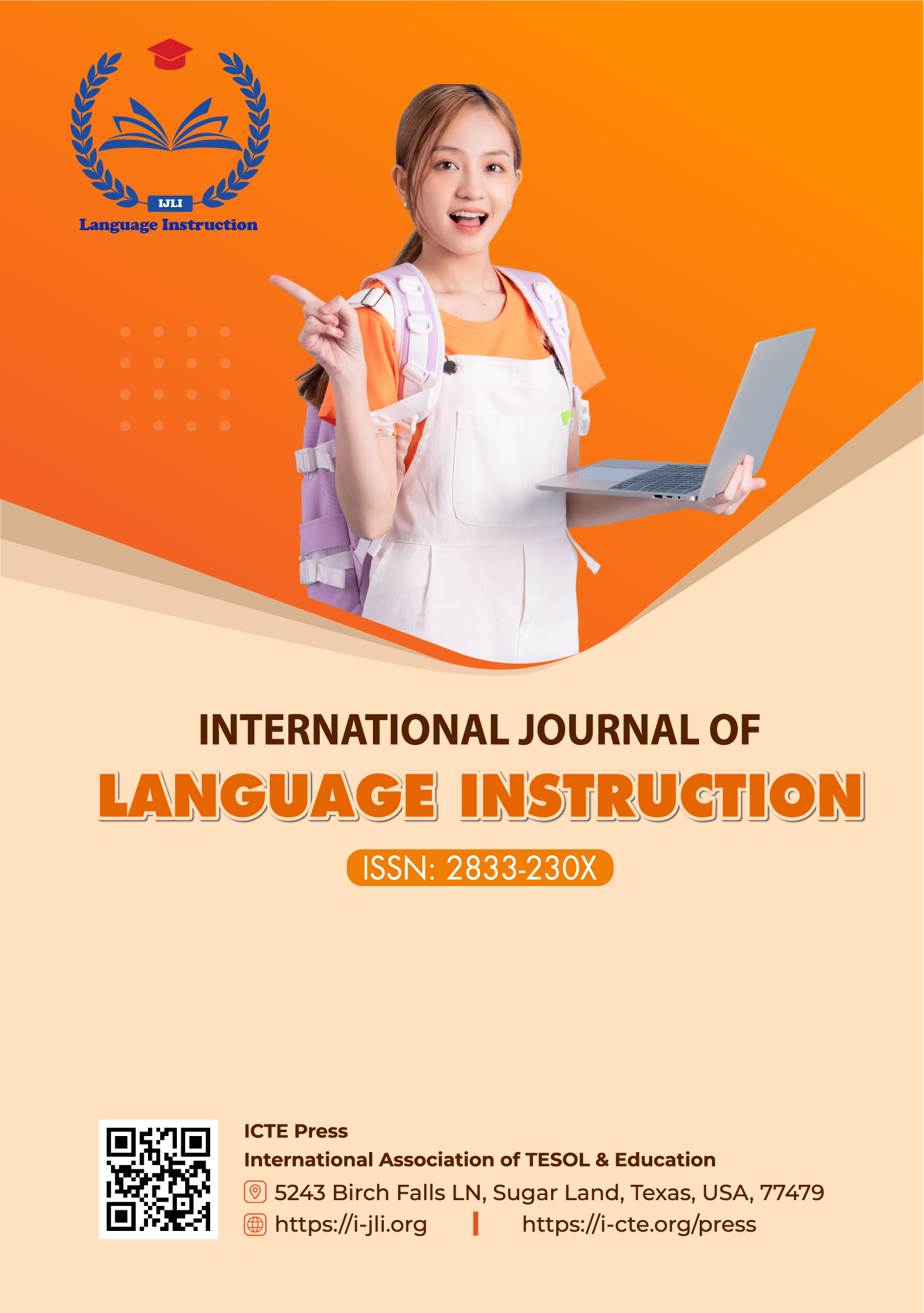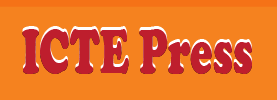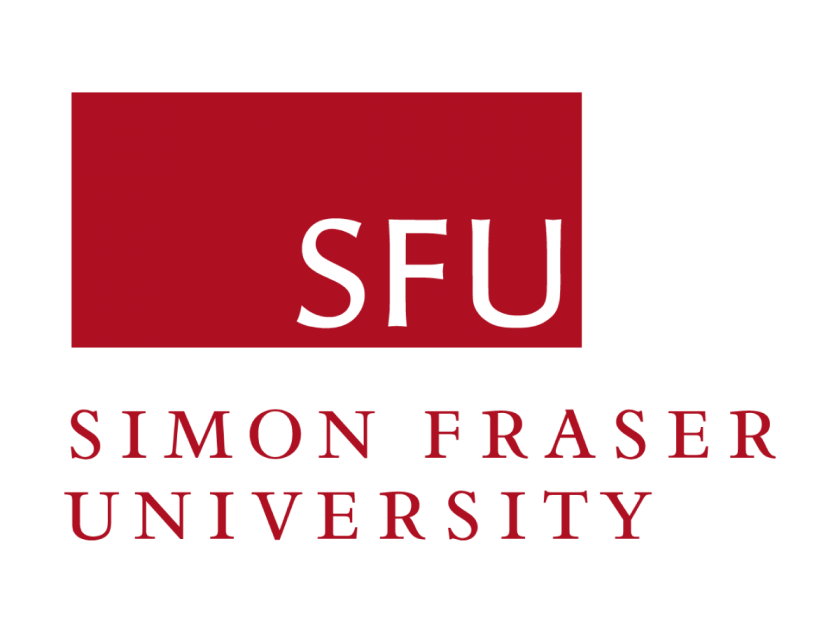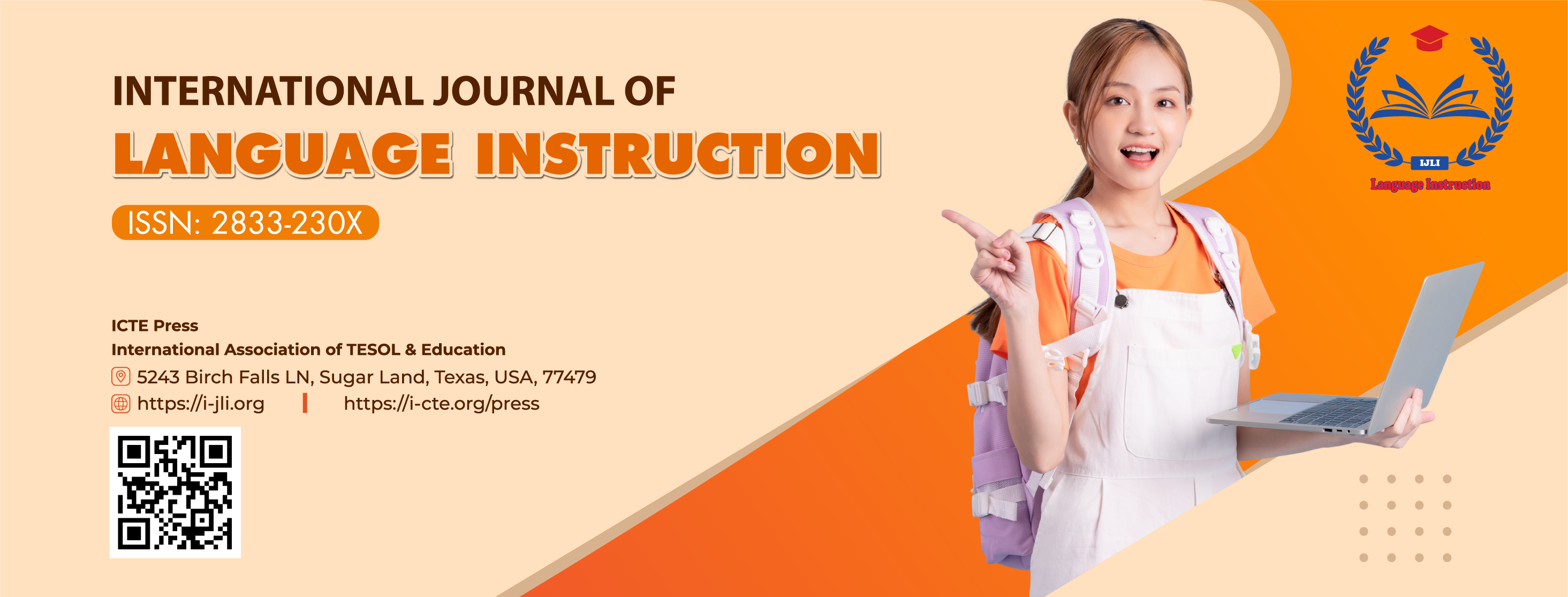Linguistic Creativity in Japanese High School Students' Haikus: A Qualitative Analysis
DOI:
https://doi.org/10.54855/ijli.25435Keywords:
Linguistic creativity, haiku composition, Japanese junior high school studentsAbstract
Although haiku has gained attention as a pedagogical tool in second language (L2) instruction, its use in junior high school EFL classrooms remains underexplored. This study examines how Japanese junior high school students navigate the limitations of haiku to create meaningful and imaginative expressions of language. A qualitative descriptive analysis was conducted on 52 student-written haikus from a classroom-based writing activity. Findings reveal students demonstrate lexical creativity through vivid sensory imagery, nature-based vocabulary, emotional expressions, and modern references. Syntactic creativity emerges in omitted subjects and verbs, unconventional word order, and fragmented structure. Figurative language use, including metaphor and symbolism, enables students to convey complex emotions and abstract ideas. Thematic analysis highlights recurring themes such as seasonal imagery, nostalgia, personal reflection, and contemporary influences like technology. The study highlights haiku’s pedagogical value in fostering self-expression, linguistic precision, and cultural engagement. This demonstrates that structural limitations can serve as a catalyst for linguistic and creative development in young EFL learners.
References
Abdelkadir, A. M. (2023). Learning language skills through poetry. Global Libyan Journal, (60). https://doi.org/10.37376/glj.vi60.4422
Akintayo, O. (2024). Cross-cultural instructional design: A framework for multilingual and interdisciplinary education. International Journal of Applied Research in Social Sciences, 6(5), 785-800. https://doi.org/10.51594/ijarss.v6i5.1101
Alanezi, M. (2024). The impact of the IELTS writing test on postgraduate students in Kuwait. International Journal of English Language Teaching, 12(2), 42-51. https://doi.org/10.37745/ijelt.13/vol12n24251
Anggiamurni, A. (2020). An analysis of figurative language in poetry by Maya Angelou. Panyonara Journal of English Education, 2(2), 149. https://doi.org/10.19105/panyonara.v2i2.3669
Arcilla Jr., F. (2024). Poetic devices, thematic significance, and social realities in poetry: A critical literature review. Randwick International of Education and Linguistics Science Journal, 5(1), 70-85. https://doi.org/10.47175/rielsj.v5i1.935
Ariani, D. (2024). Thematic video stimulates student imagination for poetry writing course. Isllac Journal of Intensive Studies on Language Literature Art and Culture, 8(1), 145. https://doi.org/10.17977/um006v8i12024p145-159
Baer, J. (2024). How to teach creativity when there's no such thing as creativity. The Journal of Creative Behavior. 1–6. https://doi.org/10.1002/jocb.1518
Banegas, D., & Lowe, R. (2021). Creative writing for publication: An action research study of motivation, engagement, and language development in Argentinian secondary schools. Studies in Second Language Learning and Teaching, 11(3), 401-421. https://doi.org/10.14746/ssllt.2021.11.3.5
Bezugla, L., & Tkachivska, M. (2022). Types and functions of sound writing in lyrical poems by Rainer Maria Rilke. Accents and Paradoxes of Modern Philology, 1(7), 7-33. https://doi.org/10.26565/2521-6481-2022-7-01
Bielo, J. (2019). “Particles‐to‐people…molecules‐to‐man”: Creationist poetics in public debates. Journal of Linguistic Anthropology, 29(1), 4-26. https://doi.org/10.1111/jola.12205
Carter, R. (2004). Talking, creating: Interactional language, creativity, and context. Applied Linguistics, 25(1), 62-88. https://doi.org/10.1093/applin/25.1.62
Corsino, S., Lim, R., & Reyes, K. (2022). The correlates of language learning motivation of senior high school students. Journal of World Englishes and Educational Practices, 4(1), 01-09. https://doi.org/10.32996/jweep.2022.4.1.1
Crahay, G. (2024). The benefits and challenges of creative writing assessment in French. ETLHE, 1, 5-20. https://doi.org/10.62512/etlhe.3
Cuong, D. (2024). Building an innovative learning ecosystem: A model for secondary schools in Hanoi, Vietnam. Tem Journal, 13(3), 2115-2126. https://doi.org/10.18421/TEM133-39
Dang, T. H. N. (2024). EFL students’ perceptions of peer feedback in writing classes at a university in HCM City. International Journal of Language Instruction, 3(2), 18–28. https://doi.org/10.54855/ijli.24322
Eriksson, A. (2022). Creative writing and how it can support second language learners (Bachelor’s thesis). Malmö University. Retrieved from https://www.diva-portal.org/smash/get/diva2:1676349/FULLTEXT01.pdf
Fithriani, R. (2021). Poetry writing in EFL classrooms: Learning from Indonesian students’ strategies. Kne Social Sciences 5(4), 59-75. https://doi.org/10.18502/kss.v5i4.8667
Fitria, T. (2024). Creative writing skills in English: Developing student's potential and creativity. Ebony Journal of English Language Teaching Linguistics and Literature, 4(1), 1-17. https://doi.org/10.37304/ebony.v4i1.10908
Flick, U. (2014). The SAGE handbook of qualitative data analysis. (Vols. 1-0). SAGE Publications Ltd, https://doi.org/10.4135/9781446282243
Friedenberg, J., Farrelly, C., Cameron, I., & Mourani, R. (2023). The linguistic structure of haiku/senryu and its evolution over time. Empirical Studies of the Arts, 42(1), 240-259. https://doi.org/10.1177/02762374231185299
Furman, R., Langer, C., Davis, C., Gallardo, H., & Kulkarni, S. (2007). Expressive, research and reflective poetry as qualitative inquiry: A study of adolescent identity. Qualitative Research, 7(3), 301-315. https://doi.org/10.1177/1468794107078511
Gao, L. & Zhang, L. (2020). Teacher learning in difficult times: Examining foreign language teachers’ cognitions about online teaching to tide over covid-19. Frontiers in Psychology, 11. https://doi.org/10.3389/fpsyg.2020.549653
Ghani, M. & Din, M. (2017). The effect of teaching English through literature on creative writing at hssc level in Pakistan. International Journal of English Linguistics, 7(2), 142. https://doi.org/10.5539/ijel.v7n2p142
Gil, T. (2018). Meaningful learning through art: Nature photography, haiku writing, mobile technologies and social media as a path to oneself. International Journal of Art & Design Education, 38(2), 360-375. https://doi.org/10.1111/jade.12192
Hancı-Azizoğlu, B. (2018). Creative writing as a second language: What is creativity for second language writers?. Tesol Journal, 9(4), 1-13. https://doi.org/10.1002/tesj.424
Higginson, W. J., & Harter, P. (1985). The Haiku handbook: How to write, share, and teach haiku. Kodansha International.
Hitsuwari, J. & Nomura, M. (2021). How individual states and traits predict aesthetic appreciation of haiku poetry. Empirical Studies of the Arts, 40(1), 81-99. https://doi.org/10.1177/0276237420986420
Hitsuwari, J. & Nomura, M. (2022). Ambiguity tolerance can improve through poetry appreciation and creation. The Journal of Creative Behavior, 57(2), 178-185. https://doi.org/10.1002/jocb.574
Hong-Nguyen, G., & Wolff, M. R. (2019). An analysis of haiku teaching discourse: From talking about to doing haiku. Journal of Pedagogical Research, 3(3), 113–125. https://doi.org/10.33902/jpr.v3i3.93
Huh, K. & Lee, J. (2019). Fostering creativity and language skills of foreign language learners through smart learning environments: Evidence from fifth‐grade Korean EFL learners. Tesol Journal, 11(2). https://doi.org/10.1002/tesj.489
Ihanus, J. (2022). Therapeutic poems for advancing coping, empathy, and cultural well-being. Creative Arts in Education and Therapy, 8(1), 18-31. https://doi.org/10.15212/CAET/2022/8/8
Iida, A. (2016). Poetic identity in second language writing: Exploring an EFL learner’s study abroad experience. Eurasian Journal of Applied Linguistics, 2(1), 1-14. https://doi.org/10.32601/ejal.460985
Iida, A. (2017). Expressing voice in a foreign language: Multiwriting haiku pedagogy in the EFL context. Teflin Journal - A Publication on the Teaching and Learning of English, 28(2), 260. https://doi.org/10.15639/teflinjournal.v28i2/260-276
Indrawati, T., Sukma, E., Suriani, A., & Fadillah, N. (2020). The problem of teachers in learning to write poetry in elementary school. https://doi.org/10.4108/eai.20-6-2020.2300721
Iñiguez, J. & Pacheco, F. (2022). Developing academic writing skills in EFL university students through haiku composition. Revista Electrónica Educare, 26(1), 1-17. https://doi.org/10.15359/ree.26-1.11
Jesudas, R. & Sajeevlal, U. (2022). Insights into teaching figurative languages in poetry using advertisement medium: A case study. Journal of English Language Teaching and Applied Linguistics, 4(4), 18-30. https://doi.org/10.32996/jeltal.2022.4.4.4
Jones, R. (2010). Creativity and discourse. World Englishes, 29(4), 467-480. https://doi.org/10.1111/j.1467-971x.2010.01675.x
Jones, R. (2019). Creativity in language learning and teaching: Translingual practices and transcultural identities. Applied Linguistics Review, 11(4), 535-550. https://doi.org/10.1515/applirev-2018-0114
Kato, J. (2024). Association between the creative experience of haiku poetry and a tendency toward self‐transcendent emotions. The Journal of Creative Behavior, 58(3), 313-320. https://doi.org/10.1002/jocb.657
Khan, A., Khan, I., & Gul, N. (2023). Exploring stylistic elements in Daud Kamal’s poem plough & amp; oxen. JPR, 9(4), 318-322. https://doi.org/10.61506/02.00154
Kim, J. (2022). Korean EFL students building and sustaining new perspectives through global literary texts. Sustainability, 14(3), 1372. https://doi.org/10.3390/su14031372
Kirss, L., Säälik, Ü., Leijen, Ä., & Pedaste, M. (2021). School effectiveness in multilingual education: A review of success factors. Education Sciences, 11(5), 193. https://doi.org/10.3390/educsci11050193
Kolb, W., Dressler, W., & Mattiello, E. (2023). Human and machine translation of occasionalisms in literary texts. Target International Journal of Translation Studies, 35(4), 540-572. https://doi.org/10.1075/target.21147.kol
Lila, J. (2023). Syntactic combinations in Frederik Rreshpe’s poetry. Interdisciplinary Journal of Research and Development, 10(3), 84. https://doi.org/10.56345/ijrdv10n312
Liu, T., Li, P., Zhang, S., & Liu, W. (2022). Using daily creativity planning to promote creative behavior. The Journal of Creative Behavior, 57(1), 82-95. https://doi.org/10.1002/jocb.563
Manzoor, H., Azhar, S., & Malik, F. (2020). Observing the effectiveness of task based approach in teaching narrative essay at a private university. International Journal of English Linguistics, 10(2), 128. https://doi.org/10.5539/ijel.v10n2p128
Mardiningrum, A. (2024). Creative writing for EFL classroom: A perspective from higher education. Journal of Languages and Language Teaching, 12(1), 546. https://doi.org/10.33394/jollt.v12i1.8888
Marina, O. S. (2018). Paradoxicality in modern English poetic discourse: Testing boundaries of linguistic Research in the 21st Century. Cognition, Communication, Discourse, (15), 39-50. https://doi.org/10.26565/2218-2926-2017-15-03
Matsumoto, Y., Maeda, H., Wan, E., Bansal, D., & Tayag, P. (2023). Intergenerational haiku-making activity: Creating meaningful connections across generations. Innovation in Aging, 7(Supplement_1), 594-594. https://doi.org/10.1093/geroni/igad104.1945
Mayring, P. (2014). Qualitative content analysis: Theoretical foundation, basic procedures and software solution. Klagenfurt, Austria: Alpen-Adria Universität. https://nbn-resolving.de/urn:nbn:de:0168-ssoar-395173
Miles, M. B., Huberman, A. M., & Saldaña, J. (2014). Qualitative data analysis: A methods sourcebook (3rd ed.). SAGE Publications.
Mróz, A., & Ocetkiewicz, I. (2021). Creativity for sustainability: How do Polish teachers develop students’ creativity competence? Analysis of research results. Sustainability, 13(2), 571. https://doi.org/10.3390/su13020571
Phan, T. T. Q. (2023). EFL students’ perceptions towards cooperative learning in writing skills at a university in the Mekong Delta. International Journal of Language Instruction, 2(3), 48–62. https://doi.org/10.54855/ijli.23232
Ramlan, M. (2021). Hana wa sakuragi: Discourse analysis of cherry blossoms in haiku of ‘the great four’. Japanese Research on Linguistics Literature and Culture, 4(1), 1-15. https://doi.org/10.33633/jr.v4i1.5285
Romanova, L. (2023). “Native land” by A. I. Sofronov and “river” by A. E. Kulakovsky: Literary translations in the formation of Yakut poetry. Filologičeskie Nauki Voprosy Teorii I Praktiki, 16(12), 4262-4270. https://doi.org/10.30853/phil20230648
Rosenhan, C. & Galloway, N. (2019). Creativity, self-reflection and subversion: Poetry writing for global Englishes awareness raising. System, 84, 1-13. https://doi.org/10.1016/j.system.2019.04.005
Sadiq, U. (2023). Cultivating creative writing skills through stylistics in the classroom. Pakistan Journal of Humanities and Social Sciences, 11(3). https://doi.org/10.52131/pjhss.2023.1103.0636
Sage, C. & Null, N. (2022). Short form design projects. SACAD. https://doi.org/10.58809/pxdq8627
Sakaryalı, Ö., Bal, M., & Yıldırım, Y. (2024). Investigating the relationship between mother tounge education and creativity: A systematic review at the K-12 level. SAGE Open, 14(4). Article 21582440241307806. https://doi.org/10.1177/21582440241307806
Santillán-Iñiguez, J., Arévalo-Chuquín, M., Heras-Urgilés, E., Hidalgo-Camacho, C., Orellana-Mora, X., & Piedra-Carrión, V. (2023). The influence of haiku composition tasks on the development of academic writing skills: A qualitative analysis. International Journal of Learning Teaching and Educational Research, 22(9), 550-570. https://doi.org/10.26803/ijlter.22.9.30
Stephenson, K. & Rosen, D. (2015). Haiku and healing. Empirical Studies of the Arts, 33(1), 36-60. https://doi.org/10.1177/0276237415569981
Sulastri, F., Sri, M., & Syakira, S. (2022). Utilizing haiku as a learning reflection: Students’ perception. Al-Ishlah Jurnal Pendidikan, 14(3), 4505-4512. https://doi.org/10.35445/alishlah.v14i3.1545
Sundari, H., Febriyanti, R., & Saragih, G. (2018). Using task-based materials in teaching writing for EFL classes in Indonesia. International Journal of Applied Linguistics & English Literature, 7(3), 119. https://doi.org/10.7575/aiac.ijalel.v.7n.3p.119
Tamesis, F., Prendol, D., Ungriano, E., Rodriguez, C., Prudente, M., & Llames, J. (2022). Figurative language competence and poetry writing skills of senior high school students. International Journal of Research Publications, 112(1). https://doi.org/10.47119/ijrp10011211120224070
Vandaele, J. (2021). Cognitive poetics and the problem of metaphor. In P. Stockwell & S. Whiteley (Eds), The Routledge handbook of stylistics (2nd ed., pp. 450-483). Routledge https://doi.org/10.4324/9781351034708-31
Williams, D. & Shipley, G. (2019). Japanese poems with strong nature themes as a tool for environmental education. Creative Education, 10(11), 2457-2472. https://doi.org/10.4236/ce.2019.1011174
Yazdanjoo, S. & Fallahpour, H. (2018). A study on the correlation between creative thinking of Iranian EFL learners and using metaphor in descriptive writing tasks. International Journal of English Language and Literature Studies, 7(2), 32-44. https://doi.org/10.18488/journal.23.2018.72.32.44
Yuana, M., Huda, M., & Ma’ruf, A. I. (2023). Application of learning strategies for writing poetry based on idols in high school students. In Proceedings of the International Conference on Learning and Advanced Education (ICOLAE 2022).1256–1274. Atlantis Press. https://doi.org/10.2991/978-2-38476-086-2_105
Zhang, Y., & Wang, X. (2025). The impact of sensory modalities and background information on the emotional resonance of Li Bai's classical poetry. Frontiers in Psychology, 16. https://doi.org/10.3389/fpsyg.2025.1541680
Корольова, В. В. (2021). Color synesthesia in modern female poetry. The Journal of V. N. Karazin Kharkiv National University. Series “Philology”, (88), 56-59. https://doi.org/10.26565/2227-1864-2021-88-08
Downloads
Published
Issue
Section
License
Copyright (c) 2025 Robert G. Arrogante

This work is licensed under a Creative Commons Attribution 4.0 International License.
The copyright of all articles published in the International Journal of Language Instruction (ijli) remains with the Authors, i.e. Authors retain full ownership of their article. Permitted third-party reuse of the open access articles is defined by the applicable Creative Commons (CC) end-user license which is accepted by the Authors upon submission of their paper. All articles in the ijli are published under the CC BY-NC 4.0 license, meaning that end users can freely share an article (i.e. copy and redistribute the material in any medium or format) and adapt it (i.e. remix, transform and build upon the material) on the condition that proper attribution is given (i.e. appropriate credit, a link to the applicable license and an indication if any changes were made; all in such a way that does not suggest that the licensor endorses the user or the use) and the material is only used for non-commercial purposes.
Authors are able to enter into separate, additional contractual arrangements for the non-exclusive distribution of the journal's published version of the work (e.g., post it to an institutional repository, in a journal or publish it in a book), with an acknowledgment of its initial publication in this journal.











